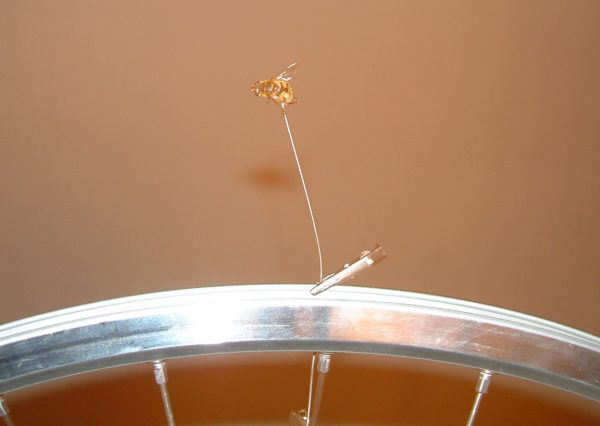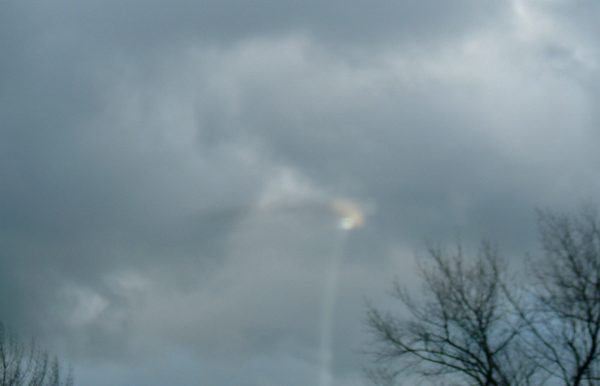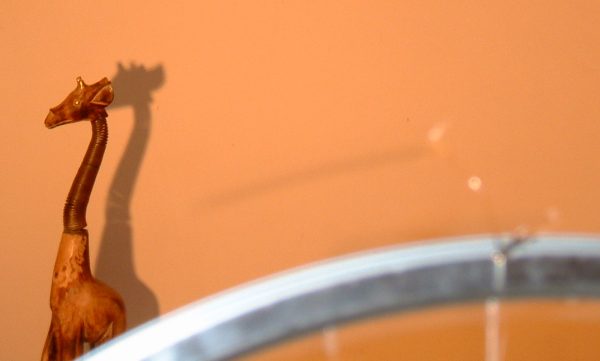Experimental reproduction of Image trail and Object
The aim of the experiment was to determine if a small object traversing the field of view of a camera focused on infinity could produce a 'streak and flash' as shown on the APOD image in question. As noted by a number of parties [1,2], a camera set for a slow exposure with flash enabled could reasonably be expected to give rise to the effect (especially if an insect happened to be blown by on the wind).
Without further ado, the experimental apparatus:

Precision Experimental Apparatus (not)
The subject (I would have asked consent, but it was dead already; geographical location was approximately central under the sofa visible in the background of the above image).

Bigger than Drosophila melanogaster (faster and harder, too)
At this point, trial runs were performed on the apparatus using a cheap digital camera focused on infinity and flash set to 'synchro' (a flash and a slow exposure, as per the original image).
During one of these trial runs, the experimental setup suffered a gravitational catastrophe following a particular inept attempt by the experimenter to get some serious rev/min-1 onto the Mavic 519 bicycle rim (Shimano XT hub, silver, not shown). As a result, the subject suffered total disintegration (well, it had been under the sofa since last summer - dust to dust, and all that).
Fortunately, a portion of yellow cardboard was available (from the experimenters frozen dinner packet) and was willing to stand in (at least, it didn't actually object when I skewered it with an old bicycle spoke). Experiment duration was approximately 15 minutes and was curtailed by the smoke alarm (due to unplanned combustion of the principal investigators dinner). The results were later examined, and the following image selected as representative.

Experimental refinements and additional results
Given the successful performance of the stand-in piece of cardboard, it was decided to repeat the experiment with the advantage of daylight (and a full stomach). Accordingly, additional experimental subjects were procured (I remembered there were a couple of wasp's nests in the attic), stuck on the end of pointy bits of wire and clipped to the wheel with crocodile clips (small, part #327-12Z3).
Again, here's the experimental subject (actually photographed post-experiment, it appears to be drooling somewhat - not surprising given what it had just been through)

The wheel was angled at about 20 degrees to a line perpendicular to the camera axis, and spun at approximately 3 revs/sec-1 (it hurt my fingers too much to go faster). This translates to a wasp velocity of around 6.5m/sec-1 (earlier reports gave an incorrect figure of 2m/sec-1because I forgot to multiply by pi). The camera was located ~0.6m (measured optically, i.e. I looked at the distance and guessed) from the subject, focused on infinity (roughly - it's not an SLR and the built-in screen's not of the quality a careful experimenter like me should have to put up with), synchro flash and about 1/2 way though its optical zoom range of 8.3 to 24.9mm (Fuji Finepix 6800).
And here's the result - a strange streak and a blobby object at the end.

Addendum - Tuesday 21st December 2004
Although I don't like to be known as the kind of guy who keeps dead bodies around the house, in this case I did hang on to the corpses of my experimental subjects (on the offchance I might want to play with them again).
But given there were a few comments querying the length of my particular trail of the dead, I decided to have a shot (or hundred) at extending it. In particular, examining the EXIF data for the picture above revealed the exposue duration was about 1/180th second - far shorter than the 1/20th second of the original APOD image (and hence the relatively short trail).
So, although my camera doesn't allow manual settings of exposure, with a certain amount of messing about with the lighting, I managed to convinced it to shoot at 1/17th second (as reported by the EXIF data). In the image below, the fine wooden giraffe was placed in the background as something to focus on (it's actually about 20 feet from the camera but looks closer due to the camera zoom). The wasp-on-the-wheel is about 3 feet from the lens, and is travelling at about 5mph (in this experiment I spun the wheel much more slowly than before, here it's only doing about 1 rev/sec).

So, broadly speaking, the kind of setup that gives a good streak-and-blob (in the case of my camera anyway) is an exposure around 1/20th second with the insect about 3 feet away doing 5mph, using 'synchro flash'. With the practice I've had, I can easily reproduce the effect on pictures taken with my sophisticated (cough) experimental setup.
Also, having now shot a couple of hundred pictures showing the effect, quite a few of them show odd highlights and blobs - for example, in the picture above, the blob just above the trail is a reflection of the flash on the upper wing of the wasp (the lower blob is glare off the supporting wire).
1. Actually, this isn't a real footnote. I just thought the [1] in the text above looked professional.
2. See [1]